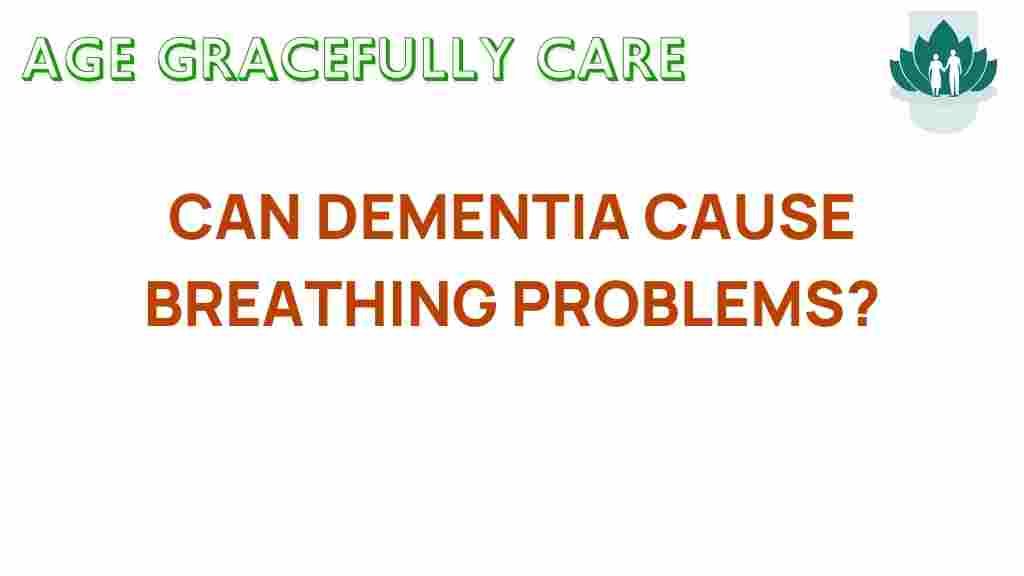Unraveling the Connection: Can Dementia Cause Breathing Problems?
Dementia is a complex neurological disorder that affects millions of elderly individuals worldwide. As cognitive decline progresses, it can lead to various health risks, including potential respiratory issues. Understanding the intricate relationship between dementia and breathing problems is essential for effective elderly care and patient care. In this article, we will explore this connection in detail, shedding light on how cognitive decline may contribute to respiratory complications and what caregivers can do to mitigate these risks.
Understanding Dementia and Its Impact on Health
Dementia is an umbrella term used to describe various neurological disorders characterized by a decline in cognitive function. This decline affects memory, reasoning, communication, and daily functioning, posing significant challenges for both patients and caregivers. The most common types of dementia include:
- Alzheimer’s Disease
- Vascular Dementia
- Lewy Body Dementia
- Frontotemporal Dementia
As dementia progresses, individuals may experience a range of symptoms, including confusion, mood swings, and difficulty with language. However, the implications of dementia extend beyond cognitive decline, impacting overall health and well-being.
The Link Between Dementia and Breathing Problems
While dementia is primarily known for its effects on cognitive function, it can also lead to various physical health issues, including breathing problems. Here are some ways dementia may contribute to respiratory issues:
- Impaired Communication: Patients with dementia often struggle to express their needs. This can include difficulty communicating breathing difficulties, leading to delayed treatment.
- Swallowing Difficulties: Cognitive decline can affect the ability to swallow properly, increasing the risk of aspiration pneumonia, a serious respiratory condition.
- Decreased Mobility: Many individuals with dementia become less mobile, which can result in weakened respiratory muscles and reduced lung capacity.
- Behavioral Changes: Dementia can lead to anxiety and depression, which may manifest as hyperventilation or shallow breathing.
Health Risks Associated with Respiratory Issues in Dementia Patients
Breathing problems in dementia patients can lead to several health risks, including:
- Aspiration Pneumonia: This occurs when food, liquid, or saliva enters the lungs, causing infection and inflammation.
- Chronic Obstructive Pulmonary Disease (COPD): Individuals with a history of smoking or lung conditions may experience exacerbated symptoms.
- Respiratory Infections: Dementia can weaken the immune system, making individuals more susceptible to infections.
- Hypoxia: Reduced oxygen levels in the blood can lead to confusion and increased cognitive decline.
Signs of Breathing Problems in Dementia Patients
Identifying breathing problems in dementia patients can be challenging. Caregivers should be vigilant for the following signs:
- Changes in breathing patterns (rapid or shallow breathing)
- Increased respiratory effort (use of accessory muscles)
- Frequent coughing or wheezing
- Signs of distress, such as facial grimacing or agitation
- Confusion or increased confusion during episodes of breathing difficulty
Step-by-Step Process for Managing Breathing Problems
For caregivers, managing breathing problems in dementia patients involves a proactive approach. Here is a step-by-step process to ensure optimal patient care:
Step 1: Regular Monitoring
Consistent monitoring of respiratory health is crucial. Caregivers should:
- Conduct regular assessments of breathing patterns.
- Keep a log of any changes or concerns to share with healthcare professionals.
Step 2: Create a Safe Environment
Ensure the living space is conducive to respiratory health:
- Maintain clean air by using air purifiers.
- Avoid exposure to smoke, dust, and allergens.
- Encourage regular ventilation of the home.
Step 3: Optimize Nutrition and Hydration
Proper nutrition can help maintain overall health:
- Provide soft, easy-to-swallow foods to minimize the risk of choking.
- Encourage hydration to keep mucus membranes moist.
Step 4: Promote Physical Activity
Gentle physical activity can enhance lung function:
- Encourage light exercises, such as walking or stretching, based on the patient’s ability.
- Incorporate breathing exercises to strengthen respiratory muscles.
Step 5: Seek Professional Help
Don’t hesitate to involve healthcare professionals:
- Consult with a physician if breathing problems are suspected.
- Consider getting a referral to a respiratory therapist if needed.
Troubleshooting Tips for Caregivers
Addressing respiratory issues in dementia patients requires diligence and adaptability. Here are some troubleshooting tips:
- Stay Calm: If a patient is experiencing breathing difficulties, remain calm and reassure them to reduce anxiety.
- Adjust Positioning: Help the patient sit up or lean forward to facilitate easier breathing.
- Monitor Medications: Ensure that any prescribed medications for respiratory issues are taken as directed.
- Encourage Deep Breathing: Teach the patient simple deep breathing exercises to improve lung function.
- Document Incidents: Keep a detailed record of any episodes of breathing problems to discuss with healthcare providers.
Conclusion
Understanding the connection between dementia and breathing problems is crucial for providing effective elderly care. As cognitive decline progresses, the risk of respiratory issues increases, necessitating proactive monitoring and management. By being aware of the signs, creating a safe environment, and implementing a structured approach to care, caregivers can significantly improve the quality of life for dementia patients. If you suspect that a loved one may be experiencing breathing difficulties, consult with healthcare professionals for appropriate interventions.
For further information on managing dementia and its associated health risks, visit this comprehensive resource. Additionally, consider exploring this external article for more insights on elderly care practices.
This article is in the category Health and created by AgeGracefullyCare Team
